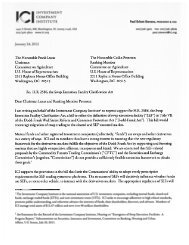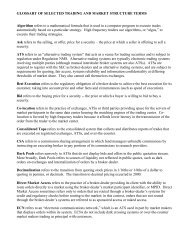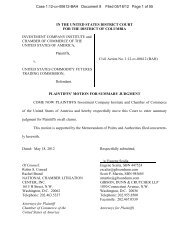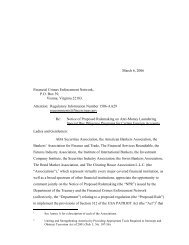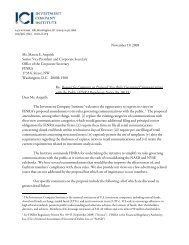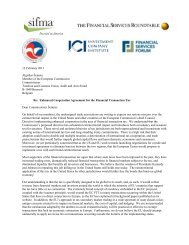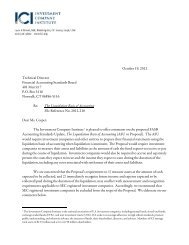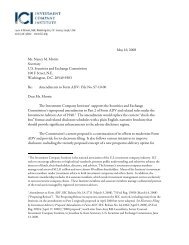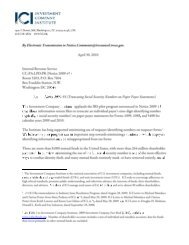Jan 2013 ICI Comment Letter to FSB on Sec Lending and Repos
Jan 2013 ICI Comment Letter to FSB on Sec Lending and Repos
Jan 2013 ICI Comment Letter to FSB on Sec Lending and Repos
Create successful ePaper yourself
Turn your PDF publications into a flip-book with our unique Google optimized e-Paper software.
<str<strong>on</strong>g>Jan</str<strong>on</strong>g>uary 14, <str<strong>on</strong>g>2013</str<strong>on</strong>g><br />
<strong>Sec</strong>retariat of the Financial Stability Board<br />
c/o Bank for Internati<strong>on</strong>al Settlements<br />
CH-4002<br />
Basel, Switzerl<strong>and</strong><br />
Dear Sir or Madam:<br />
Re: Addressing Shadow Banking Risks in <strong>Sec</strong>urities <strong>Lending</strong> <strong>and</strong> <strong>Repos</strong><br />
The Investment Company Institute 1 appreciates the opportunity <str<strong>on</strong>g>to</str<strong>on</strong>g> comment <strong>on</strong> the Financial<br />
Stability Board’s proposed policy framework for addressing risks in securities lending <strong>and</strong> repos (the<br />
“C<strong>on</strong>sultati<strong>on</strong>”). 2 Given the extent of their participati<strong>on</strong> in these markets, U.S. registered investment<br />
companies (“registered funds”) have a str<strong>on</strong>g interest in the <str<strong>on</strong>g>FSB</str<strong>on</strong>g>’s recommendati<strong>on</strong>s in this area. 3<br />
As explained in much greater detail below, we commend the <str<strong>on</strong>g>FSB</str<strong>on</strong>g> for seeking <str<strong>on</strong>g>to</str<strong>on</strong>g> identify <strong>and</strong><br />
address systemic risk c<strong>on</strong>cerns in these markets, but we oppose certain recommendati<strong>on</strong>s in the<br />
C<strong>on</strong>sultati<strong>on</strong> <strong>on</strong> the grounds that the <str<strong>on</strong>g>FSB</str<strong>on</strong>g>’s proposed regula<str<strong>on</strong>g>to</str<strong>on</strong>g>ry st<strong>and</strong>ards would inappropriately<br />
intrude <strong>on</strong> areas best left <str<strong>on</strong>g>to</str<strong>on</strong>g> nati<strong>on</strong>al regula<str<strong>on</strong>g>to</str<strong>on</strong>g>rs or market forces. Most notably, <str<strong>on</strong>g>ICI</str<strong>on</strong>g> opposes <str<strong>on</strong>g>FSB</str<strong>on</strong>g><br />
recommendati<strong>on</strong>s that would set specific fixed or minimum numerical floors for repo haircuts, limit the<br />
types of collateral repo buyers may accept, <strong>and</strong> dictate additi<strong>on</strong>al disclosure by fund managers.<br />
1<br />
The Investment Company Institute is the nati<strong>on</strong>al associati<strong>on</strong> of U.S. investment companies, including mutual funds,<br />
closed-end funds, exchange-traded funds, <strong>and</strong> unit investment trusts. <str<strong>on</strong>g>ICI</str<strong>on</strong>g> seeks <str<strong>on</strong>g>to</str<strong>on</strong>g> encourage adherence <str<strong>on</strong>g>to</str<strong>on</strong>g> high ethical<br />
st<strong>and</strong>ards, promote public underst<strong>and</strong>ing, <strong>and</strong> otherwise advance the interests of funds, their shareholders, direc<str<strong>on</strong>g>to</str<strong>on</strong>g>rs, <strong>and</strong><br />
advisers. Members of <str<strong>on</strong>g>ICI</str<strong>on</strong>g> manage <str<strong>on</strong>g>to</str<strong>on</strong>g>tal assets of $13.9 trilli<strong>on</strong> <strong>and</strong> serve over 90 milli<strong>on</strong> shareholders.<br />
2<br />
Strengthening Oversight <strong>and</strong> Regulati<strong>on</strong> of Shadow Banking: A Policy Framework for Addressing Shadow Banking Risks in<br />
<strong>Sec</strong>urities <strong>Lending</strong> <strong>and</strong> <strong>Repos</strong>, <str<strong>on</strong>g>FSB</str<strong>on</strong>g> C<strong>on</strong>sultative Document (November 18, 2012), which is available at<br />
https://www.financialstabilityboard.org/publicati<strong>on</strong>s/r_121118b.pdf.<br />
3<br />
Our comment letter <strong>on</strong> the interim report by the <str<strong>on</strong>g>FSB</str<strong>on</strong>g>’s Workstream <strong>on</strong> <strong>Sec</strong>urities <strong>Lending</strong> <strong>and</strong> <strong>Repos</strong> (“WS5”) described<br />
in more detail the extent of U.S. fund participati<strong>on</strong> in the securities lending <strong>and</strong> repo markets. Our comments <strong>on</strong> the<br />
interim report can be found at https://www.financialstabilityboard.org/publicati<strong>on</strong>s/c_120806p.pdf (the “2012 <str<strong>on</strong>g>ICI</str<strong>on</strong>g><br />
<str<strong>on</strong>g>Letter</str<strong>on</strong>g>”).
<strong>Sec</strong>retariat of the Financial Stability Board<br />
<str<strong>on</strong>g>Jan</str<strong>on</strong>g>uary 14, <str<strong>on</strong>g>2013</str<strong>on</strong>g><br />
Page 2 of 17<br />
Executive Summary<br />
We have several general comments <strong>on</strong> the C<strong>on</strong>sultati<strong>on</strong>, al<strong>on</strong>g with a number of comments <strong>on</strong><br />
specific recommendati<strong>on</strong>s made by the <str<strong>on</strong>g>FSB</str<strong>on</strong>g>. These are summarized below <strong>and</strong> explained in greater<br />
detail in the remainder of the letter.<br />
General <str<strong>on</strong>g>Comment</str<strong>on</strong>g>s<br />
• The <str<strong>on</strong>g>FSB</str<strong>on</strong>g> must clearly distinguish securities lending from repos in making its final<br />
recommendati<strong>on</strong>s. Although they are both categories of collateralized finance,<br />
securities lending <strong>and</strong> repo markets are distinct <strong>and</strong> often quite different. While some<br />
of the <str<strong>on</strong>g>FSB</str<strong>on</strong>g>’s recommendati<strong>on</strong>s may apply <str<strong>on</strong>g>to</str<strong>on</strong>g> both markets, most should be tailored <str<strong>on</strong>g>to</str<strong>on</strong>g><br />
address the unique issues presented in each c<strong>on</strong>text.<br />
• While we str<strong>on</strong>gly support the <str<strong>on</strong>g>FSB</str<strong>on</strong>g>’s efforts <str<strong>on</strong>g>to</str<strong>on</strong>g> address systemic risks, it is critical that<br />
the <str<strong>on</strong>g>FSB</str<strong>on</strong>g> take a balanced approach <str<strong>on</strong>g>to</str<strong>on</strong>g> its recommendati<strong>on</strong>s. In its final report, the <str<strong>on</strong>g>FSB</str<strong>on</strong>g><br />
should explicitly recognize not <strong>on</strong>ly the potential risks with regard <str<strong>on</strong>g>to</str<strong>on</strong>g> securities lending<br />
<strong>and</strong> repo financing, but also the benefits of those activities <strong>and</strong> the ways in which<br />
existing regulati<strong>on</strong> or market practices in some jurisdicti<strong>on</strong>s already mitigate systemic<br />
risks.<br />
• Given the differences in securities lending <strong>and</strong> repo markets around the world <strong>and</strong><br />
differences in the extent of existing regulati<strong>on</strong>, the <str<strong>on</strong>g>FSB</str<strong>on</strong>g> should take a less prescriptive<br />
approach with its final recommendati<strong>on</strong>s. In most cases, the <str<strong>on</strong>g>FSB</str<strong>on</strong>g> should encourage<br />
nati<strong>on</strong>al regula<str<strong>on</strong>g>to</str<strong>on</strong>g>rs <str<strong>on</strong>g>to</str<strong>on</strong>g> c<strong>on</strong>sider its recommendati<strong>on</strong>s in light of the particular<br />
circumstances in their market, rather than directing these regula<str<strong>on</strong>g>to</str<strong>on</strong>g>rs <str<strong>on</strong>g>to</str<strong>on</strong>g> adopt a specific<br />
type of requirement.<br />
Specific <str<strong>on</strong>g>Comment</str<strong>on</strong>g>s<br />
• We support the <str<strong>on</strong>g>FSB</str<strong>on</strong>g>’s efforts <str<strong>on</strong>g>to</str<strong>on</strong>g> ensure that authorities have the informati<strong>on</strong> they need<br />
<str<strong>on</strong>g>to</str<strong>on</strong>g> effectively m<strong>on</strong>i<str<strong>on</strong>g>to</str<strong>on</strong>g>r securities lending <strong>and</strong> repo markets for systemic risks. In<br />
gathering data, authorities should: (1) request <strong>on</strong>ly the informati<strong>on</strong> they need <str<strong>on</strong>g>to</str<strong>on</strong>g><br />
m<strong>on</strong>i<str<strong>on</strong>g>to</str<strong>on</strong>g>r for systemic risks in the markets; (2) gather that informati<strong>on</strong> in the most<br />
efficient way reas<strong>on</strong>ably available; <strong>and</strong> (3) have appropriate systems <strong>and</strong> procedures in<br />
place <str<strong>on</strong>g>to</str<strong>on</strong>g> ensure the c<strong>on</strong>fidentiality <strong>and</strong> security of such informati<strong>on</strong> before requesting it<br />
from market participants.<br />
• The collecti<strong>on</strong> of data by regula<str<strong>on</strong>g>to</str<strong>on</strong>g>rs is <strong>on</strong>e area where we favor a globally harm<strong>on</strong>ized<br />
approach, although the process through which regula<str<strong>on</strong>g>to</str<strong>on</strong>g>rs could gain access <str<strong>on</strong>g>to</str<strong>on</strong>g><br />
c<strong>on</strong>sistent <strong>and</strong> comprehensive data without imposing duplicative or incompatible<br />
reporting obligati<strong>on</strong>s <strong>on</strong> market participants will need <str<strong>on</strong>g>to</str<strong>on</strong>g> be developed through further
<strong>Sec</strong>retariat of the Financial Stability Board<br />
<str<strong>on</strong>g>Jan</str<strong>on</strong>g>uary 14, <str<strong>on</strong>g>2013</str<strong>on</strong>g><br />
Page 3 of 17<br />
c<strong>on</strong>sultati<strong>on</strong>s with industry <strong>and</strong> a careful review of existing processes <strong>and</strong> available<br />
informati<strong>on</strong>.<br />
• We generally support the public release of data <strong>on</strong> an aggregated basis <str<strong>on</strong>g>to</str<strong>on</strong>g> the extent<br />
such disclosure advances the goal of mitigating systemic risk. That said, the ec<strong>on</strong>omic<br />
terms of securities lending transacti<strong>on</strong>s, such as fee splits, should not be publicly<br />
disclosed. It would be difficult <str<strong>on</strong>g>to</str<strong>on</strong>g> disclose aggregated data <strong>on</strong> these terms in a<br />
meaningful way. Even if that could be d<strong>on</strong>e, such disclosure is unnecessary <str<strong>on</strong>g>to</str<strong>on</strong>g> mitigate<br />
systemic risks.<br />
• We oppose the <str<strong>on</strong>g>FSB</str<strong>on</strong>g>’s recommendati<strong>on</strong>s with respect <str<strong>on</strong>g>to</str<strong>on</strong>g> corporate disclosure <strong>and</strong> fund<br />
manager disclosure. The <str<strong>on</strong>g>FSB</str<strong>on</strong>g> should defer <str<strong>on</strong>g>to</str<strong>on</strong>g> local authorities <strong>on</strong> these types of<br />
disclosure issues, which have little or no c<strong>on</strong>necti<strong>on</strong> <str<strong>on</strong>g>to</str<strong>on</strong>g> systemic risk.<br />
• The <str<strong>on</strong>g>FSB</str<strong>on</strong>g>’s focus <strong>on</strong> repo haircuts is misplaced. It appears based <strong>on</strong> supposed procyclical<br />
trends in haircuts for which there is no his<str<strong>on</strong>g>to</str<strong>on</strong>g>rical evidence, at least for tri-party<br />
repo in the United States, <strong>and</strong> disregards the fact that many buyers enter in<str<strong>on</strong>g>to</str<strong>on</strong>g> a repo<br />
based primarily up<strong>on</strong> the seller’s capacity <str<strong>on</strong>g>to</str<strong>on</strong>g> pay the repurchase price, rather than up<strong>on</strong><br />
the value <strong>and</strong> liquidity of the collateral. Collateral is just <strong>on</strong>e fac<str<strong>on</strong>g>to</str<strong>on</strong>g>r when deciding<br />
what form or amount of credit <str<strong>on</strong>g>to</str<strong>on</strong>g> extend <str<strong>on</strong>g>to</str<strong>on</strong>g> an instituti<strong>on</strong>.<br />
• Moreover, we fundamentally disagree with any attempt <str<strong>on</strong>g>to</str<strong>on</strong>g> regulate the negotiated<br />
terms of market transacti<strong>on</strong>s such as repos, <strong>and</strong> believe that a number of problems<br />
(correctly identified <strong>and</strong> acknowledged in the C<strong>on</strong>sultati<strong>on</strong>) would result from the<br />
establishment of minimum numerical floors for repo haircuts, especially at the very<br />
high levels discussed in the C<strong>on</strong>sultati<strong>on</strong>. Accordingly, we oppose the <str<strong>on</strong>g>FSB</str<strong>on</strong>g><br />
recommendati<strong>on</strong>s that would set specific fixed or minimum floors for repo haircuts.<br />
• Finally, it is unnecessary for the <str<strong>on</strong>g>FSB</str<strong>on</strong>g> <str<strong>on</strong>g>to</str<strong>on</strong>g> set forth specific minimum regula<str<strong>on</strong>g>to</str<strong>on</strong>g>ry st<strong>and</strong>ards<br />
<strong>on</strong> collateral valuati<strong>on</strong> <strong>and</strong> management. Two of the <str<strong>on</strong>g>FSB</str<strong>on</strong>g>’s three principles in this<br />
regard have already been implemented in the U.S. <strong>and</strong> the third has nothing <str<strong>on</strong>g>to</str<strong>on</strong>g> do with<br />
collateral management <strong>and</strong> is based <strong>on</strong> a faulty premise. We specifically recommend<br />
that the <str<strong>on</strong>g>FSB</str<strong>on</strong>g>’s final recommendati<strong>on</strong>s <strong>on</strong> collateral management not limit repo market<br />
participants <str<strong>on</strong>g>to</str<strong>on</strong>g> collateral that they are able <str<strong>on</strong>g>to</str<strong>on</strong>g> hold outright following a counterparty<br />
failure. As set forth in the C<strong>on</strong>sultati<strong>on</strong>, the <str<strong>on</strong>g>FSB</str<strong>on</strong>g>’s recommendati<strong>on</strong> might be<br />
misinterpreted <str<strong>on</strong>g>to</str<strong>on</strong>g> restrict repo buyers <strong>on</strong>ly <str<strong>on</strong>g>to</str<strong>on</strong>g> collateral that they could have purchased<br />
outright <strong>and</strong> held indefinitely for investment, which would be inc<strong>on</strong>sistent with the<br />
fundamental nature of a repo <strong>and</strong> would unduly restrict the market without lessening<br />
the risk of a “fire sale” of collateral following a counterparty default.<br />
These comments are explained in more detail below.
<strong>Sec</strong>retariat of the Financial Stability Board<br />
<str<strong>on</strong>g>Jan</str<strong>on</strong>g>uary 14, <str<strong>on</strong>g>2013</str<strong>on</strong>g><br />
Page 4 of 17<br />
The Need for a Balanced <strong>and</strong> Tailored Approach<br />
The <str<strong>on</strong>g>FSB</str<strong>on</strong>g>’s effort <str<strong>on</strong>g>to</str<strong>on</strong>g> identify <strong>and</strong> investigate potential causes of systemic risk in the global<br />
financial markets is an important policy endeavor, which we str<strong>on</strong>gly support. We urge the <str<strong>on</strong>g>FSB</str<strong>on</strong>g>, as it<br />
c<strong>on</strong>templates new policy frameworks for the securities lending <strong>and</strong> repo markets, <str<strong>on</strong>g>to</str<strong>on</strong>g> take a balanced <strong>and</strong><br />
tailored approach <str<strong>on</strong>g>to</str<strong>on</strong>g> its recommendati<strong>on</strong>s.<br />
<strong>Sec</strong>urities lending <strong>and</strong> investments in repos are two of the myriad investment techniques used<br />
by U.S. registered funds <str<strong>on</strong>g>to</str<strong>on</strong>g> improve the return <strong>on</strong> their portfolios for the benefit of their shareholders.<br />
And although they are both categories of collateralized finance, securities lending <strong>and</strong> repo markets are<br />
distinct <strong>and</strong> often quite different, <strong>and</strong> are approached differently by registered funds. Due <str<strong>on</strong>g>to</str<strong>on</strong>g> strict<br />
regula<str<strong>on</strong>g>to</str<strong>on</strong>g>ry limits, securities lending is a relatively minor strategy for most U.S. registered funds, designed<br />
<str<strong>on</strong>g>to</str<strong>on</strong>g> add incremental returns with minimal additi<strong>on</strong>al risk. Registered funds are most often beneficial<br />
owners of the securities being lent, taking <strong>and</strong> reinvesting cash collateral. Investments in repos may be a<br />
more prominent strategy for some registered funds, particularly m<strong>on</strong>ey market funds. Funds that enter<br />
in<str<strong>on</strong>g>to</str<strong>on</strong>g> repos do so <strong>on</strong>ly with high quality counterparties, <strong>and</strong> most frequently enter in<str<strong>on</strong>g>to</str<strong>on</strong>g> repos as a<br />
collateralized short term cash investment (i.e., they are the inves<str<strong>on</strong>g>to</str<strong>on</strong>g>rs receiving n<strong>on</strong>-cash collateral <str<strong>on</strong>g>to</str<strong>on</strong>g><br />
secure the repo). 4<br />
In making its final recommendati<strong>on</strong>s, the <str<strong>on</strong>g>FSB</str<strong>on</strong>g> should take account of these differences <strong>and</strong><br />
clearly distinguish securities lending from repos. While some of the <str<strong>on</strong>g>FSB</str<strong>on</strong>g>’s recommendati<strong>on</strong>s may apply<br />
<str<strong>on</strong>g>to</str<strong>on</strong>g> both markets, most should be tailored <str<strong>on</strong>g>to</str<strong>on</strong>g> address the unique issues presented in each c<strong>on</strong>text. The<br />
<str<strong>on</strong>g>FSB</str<strong>on</strong>g> even may wish <str<strong>on</strong>g>to</str<strong>on</strong>g> c<strong>on</strong>sider making two separate sets of final recommendati<strong>on</strong>s, <strong>on</strong>e for securities<br />
lending <strong>and</strong> <strong>on</strong>e for repos.<br />
It also is critical that the <str<strong>on</strong>g>FSB</str<strong>on</strong>g> take account of not <strong>on</strong>ly the potential risks of a given activity, but<br />
also the benefits of that activity <strong>and</strong> the ways in which existing regulati<strong>on</strong> or market practices in some<br />
jurisdicti<strong>on</strong>s already have been developed <str<strong>on</strong>g>to</str<strong>on</strong>g> mitigate those risks. For the most part, the C<strong>on</strong>sultati<strong>on</strong><br />
does not do so, perhaps because it would be impractical <str<strong>on</strong>g>to</str<strong>on</strong>g> attempt <str<strong>on</strong>g>to</str<strong>on</strong>g> highlight existing regulati<strong>on</strong>s or<br />
beneficial market practices in a report that covers both securities lending <strong>and</strong> repo markets across the<br />
globe. By focusing almost entirely <strong>on</strong> the potential risks in securities lending <strong>and</strong> repo markets,<br />
however, the C<strong>on</strong>sultati<strong>on</strong> presents an unbalanced view. 5<br />
The <str<strong>on</strong>g>FSB</str<strong>on</strong>g> should expressly recognize that, at least in some jurisdicti<strong>on</strong>s, existing regula<str<strong>on</strong>g>to</str<strong>on</strong>g>ry<br />
requirements <strong>and</strong> recent market developments mitigate financial stability c<strong>on</strong>cerns. The <str<strong>on</strong>g>FSB</str<strong>on</strong>g>’s<br />
recommendati<strong>on</strong>s are premised <strong>on</strong> the opposite assumpti<strong>on</strong>. In the introducti<strong>on</strong>, the C<strong>on</strong>sultati<strong>on</strong><br />
4<br />
The Federal Reserve Bank of New York’s white paper <strong>on</strong> tri-party repo provides a comprehensive descripti<strong>on</strong> of the repo<br />
market <strong>and</strong> the role m<strong>on</strong>ey market funds play in it as cash inves<str<strong>on</strong>g>to</str<strong>on</strong>g>rs. See Tri-Party Repo Infrastructure Reform (May 17,<br />
2010), available at http://www.newyorkfed.org/banking/nyfrb_triparty_whitepaper.pdf.<br />
5<br />
Indeed, the C<strong>on</strong>sultati<strong>on</strong> explains the benefits of securities lending <strong>and</strong> repo financing in just three sentences at the outset.
<strong>Sec</strong>retariat of the Financial Stability Board<br />
<str<strong>on</strong>g>Jan</str<strong>on</strong>g>uary 14, <str<strong>on</strong>g>2013</str<strong>on</strong>g><br />
Page 5 of 17<br />
explains that “whereas banks are subject <str<strong>on</strong>g>to</str<strong>on</strong>g> a well-developed system of prudential regulati<strong>on</strong> <strong>and</strong> other<br />
safeguards, the shadow banking system is typically subject <str<strong>on</strong>g>to</str<strong>on</strong>g> less stringent, or no, oversight<br />
arrangements.” 6 This statement is simply not true in the case of U.S. registered funds. Far from being<br />
subject <str<strong>on</strong>g>to</str<strong>on</strong>g> little or no oversight, these funds are am<strong>on</strong>g the most highly regulated firms in all financial<br />
services. They engage in securities lending <strong>and</strong> repo in accordance with the Investment Company Act<br />
of 1940 (the “ICA”) <strong>and</strong> <strong>on</strong>ly if permitted by their organizing documents, disclosed <str<strong>on</strong>g>to</str<strong>on</strong>g> inves<str<strong>on</strong>g>to</str<strong>on</strong>g>rs in their<br />
prospectus or statement of additi<strong>on</strong>al informati<strong>on</strong> (“SAI”), <strong>and</strong> subject <str<strong>on</strong>g>to</str<strong>on</strong>g> approval <strong>and</strong> oversight by<br />
their boards of direc<str<strong>on</strong>g>to</str<strong>on</strong>g>rs. And these particular investment techniques also are highly regulated. The<br />
staff of the U.S. <strong>Sec</strong>urities <strong>and</strong> Exchange Commissi<strong>on</strong> (“SEC”) has established guidelines for securities<br />
lending activities for registered funds. Am<strong>on</strong>g other things, these guidelines restrict the types of<br />
collateral that are permissible <strong>and</strong> how that collateral may be treated, impose limitati<strong>on</strong>s <strong>on</strong> the amount<br />
of lending, ensure the ability of a fund <str<strong>on</strong>g>to</str<strong>on</strong>g> recall securities in a timely manner, <strong>and</strong> address potential<br />
c<strong>on</strong>flicts of interest. Similarly, Rule 2a-7—the primary rule under the ICA that regulates U.S. m<strong>on</strong>ey<br />
market funds—imposes strict minimum st<strong>and</strong>ards for the credit quality, maturity, diversificati<strong>on</strong> <strong>and</strong><br />
liquidity requirements of a m<strong>on</strong>ey market fund’s investments, including repos. In additi<strong>on</strong>, the rule<br />
requires the funds <str<strong>on</strong>g>to</str<strong>on</strong>g> evaluate the repo counterparty’s creditworthiness as a prerequisite <str<strong>on</strong>g>to</str<strong>on</strong>g> engaging in a<br />
repo transacti<strong>on</strong>.<br />
Moreover, market practices with respect <str<strong>on</strong>g>to</str<strong>on</strong>g> both securities lending <strong>and</strong> repos in the U.S. have<br />
been enhanced since the 2008 crisis in many ways that significantly reduce intraday credit risk, increase<br />
transparency (including with respect <str<strong>on</strong>g>to</str<strong>on</strong>g> extensive disclosure requirements as <str<strong>on</strong>g>to</str<strong>on</strong>g> fund holdings <strong>and</strong><br />
performance), <strong>and</strong> mitigate counterparty credit, liquidity, <strong>and</strong> credit quality risks. These developments<br />
are discussed at length in our letter <strong>on</strong> the <str<strong>on</strong>g>FSB</str<strong>on</strong>g>’s initial c<strong>on</strong>sultati<strong>on</strong>. 7<br />
We c<strong>on</strong>tinue <str<strong>on</strong>g>to</str<strong>on</strong>g> believe that, in additi<strong>on</strong> <str<strong>on</strong>g>to</str<strong>on</strong>g> protecting inves<str<strong>on</strong>g>to</str<strong>on</strong>g>rs, many of the regula<str<strong>on</strong>g>to</str<strong>on</strong>g>ry<br />
requirements <strong>and</strong> recent market developments should allay the <str<strong>on</strong>g>FSB</str<strong>on</strong>g>’s financial stability c<strong>on</strong>cerns with<br />
respect <str<strong>on</strong>g>to</str<strong>on</strong>g> U.S. registered funds’ participati<strong>on</strong> in the securities lending <strong>and</strong> repo markets. We<br />
respectfully request that the <str<strong>on</strong>g>FSB</str<strong>on</strong>g>’s final report explicitly recognize as much.<br />
Style of Recommendati<strong>on</strong>s<br />
The <str<strong>on</strong>g>FSB</str<strong>on</strong>g> has taken <strong>on</strong> a difficult task—<str<strong>on</strong>g>to</str<strong>on</strong>g> make policy recommendati<strong>on</strong>s that are general<br />
enough <str<strong>on</strong>g>to</str<strong>on</strong>g> cover both securities lending <strong>and</strong> repo, specific enough <str<strong>on</strong>g>to</str<strong>on</strong>g> res<strong>on</strong>ate in many different<br />
jurisdicti<strong>on</strong>s around the world, flexible enough <str<strong>on</strong>g>to</str<strong>on</strong>g> be implementable by nati<strong>on</strong>al <strong>and</strong> regi<strong>on</strong>al<br />
regula<str<strong>on</strong>g>to</str<strong>on</strong>g>rs, yet prescriptive enough <str<strong>on</strong>g>to</str<strong>on</strong>g> prevent the potential for “regula<str<strong>on</strong>g>to</str<strong>on</strong>g>ry arbitrage.”<br />
In our view, trying <str<strong>on</strong>g>to</str<strong>on</strong>g> achieve all of these objectives is neither achievable nor necessarily<br />
desirable in every c<strong>on</strong>text addressed in the C<strong>on</strong>sultati<strong>on</strong>. Regula<str<strong>on</strong>g>to</str<strong>on</strong>g>rs around the world ought <str<strong>on</strong>g>to</str<strong>on</strong>g> be fully<br />
6<br />
C<strong>on</strong>sultati<strong>on</strong>, at page ii.<br />
7<br />
See the 2012 <str<strong>on</strong>g>ICI</str<strong>on</strong>g> <str<strong>on</strong>g>Letter</str<strong>on</strong>g>.
<strong>Sec</strong>retariat of the Financial Stability Board<br />
<str<strong>on</strong>g>Jan</str<strong>on</strong>g>uary 14, <str<strong>on</strong>g>2013</str<strong>on</strong>g><br />
Page 6 of 17<br />
aware of each other’s approaches <strong>and</strong> ought <str<strong>on</strong>g>to</str<strong>on</strong>g> coordinate where possible, particularly in areas such as<br />
the gathering of data for regula<str<strong>on</strong>g>to</str<strong>on</strong>g>ry purposes where c<strong>on</strong>sistency of approach will both increase efficiency<br />
<strong>and</strong> improve results. But given the differences between securities lending <strong>and</strong> repo markets, <strong>and</strong><br />
differences between jurisdicti<strong>on</strong>s, absolute global regula<str<strong>on</strong>g>to</str<strong>on</strong>g>ry c<strong>on</strong>sistency is not always the best outcome.<br />
In a number of places in the C<strong>on</strong>sultati<strong>on</strong>, the <str<strong>on</strong>g>FSB</str<strong>on</strong>g>’s proposed recommendati<strong>on</strong>s are<br />
prescriptive, stating, for example, that nati<strong>on</strong>al regula<str<strong>on</strong>g>to</str<strong>on</strong>g>rs “should adopt” certain minimum regula<str<strong>on</strong>g>to</str<strong>on</strong>g>ry<br />
st<strong>and</strong>ards. 8 We recommend that the <str<strong>on</strong>g>FSB</str<strong>on</strong>g> take a less prescriptive approach with its final<br />
recommendati<strong>on</strong>s. In each case, the <str<strong>on</strong>g>FSB</str<strong>on</strong>g> should encourage nati<strong>on</strong>al regula<str<strong>on</strong>g>to</str<strong>on</strong>g>rs <str<strong>on</strong>g>to</str<strong>on</strong>g> c<strong>on</strong>sider its<br />
recommendati<strong>on</strong>s, rather than directing them <str<strong>on</strong>g>to</str<strong>on</strong>g> adopt a specific type of requirement. That kind of<br />
approach would allow nati<strong>on</strong>al regula<str<strong>on</strong>g>to</str<strong>on</strong>g>rs <str<strong>on</strong>g>to</str<strong>on</strong>g> implement the <str<strong>on</strong>g>FSB</str<strong>on</strong>g>’s recommendati<strong>on</strong>s in ways that take<br />
in<str<strong>on</strong>g>to</str<strong>on</strong>g> account existing regulati<strong>on</strong>s <strong>and</strong> local practices that mitigate systemic risk c<strong>on</strong>cerns. It might allow<br />
U.S. regula<str<strong>on</strong>g>to</str<strong>on</strong>g>rs, for example, <str<strong>on</strong>g>to</str<strong>on</strong>g> tailor their policy approach <str<strong>on</strong>g>to</str<strong>on</strong>g> repos, given the uniqueness of the triparty<br />
structure comm<strong>on</strong> in the U.S.<br />
Enhanced Transparency<br />
The C<strong>on</strong>sultati<strong>on</strong> includes a number of policy recommendati<strong>on</strong>s that seek <str<strong>on</strong>g>to</str<strong>on</strong>g> improve<br />
securities lending <strong>and</strong> repo transparency in four areas: 1) regula<str<strong>on</strong>g>to</str<strong>on</strong>g>ry reporting; 2) market data; 3)<br />
corporate disclosures; <strong>and</strong> 4) reporting by fund managers <str<strong>on</strong>g>to</str<strong>on</strong>g> end-inves<str<strong>on</strong>g>to</str<strong>on</strong>g>rs.<br />
Regula<str<strong>on</strong>g>to</str<strong>on</strong>g>ry Reporting<br />
We support many of the <str<strong>on</strong>g>FSB</str<strong>on</strong>g>’s goals <strong>and</strong> recommendati<strong>on</strong>s in the first area—regula<str<strong>on</strong>g>to</str<strong>on</strong>g>ry<br />
reporting. Without questi<strong>on</strong>, the relevant authorities should have the informati<strong>on</strong> they need <str<strong>on</strong>g>to</str<strong>on</strong>g><br />
effectively m<strong>on</strong>i<str<strong>on</strong>g>to</str<strong>on</strong>g>r securities lending <strong>and</strong> repo markets for systemic risks. We also str<strong>on</strong>gly support the<br />
<str<strong>on</strong>g>FSB</str<strong>on</strong>g>’s role in this regard, as a global approach <str<strong>on</strong>g>to</str<strong>on</strong>g> the collecti<strong>on</strong> of data would benefit every<strong>on</strong>e involved.<br />
Regula<str<strong>on</strong>g>to</str<strong>on</strong>g>rs around the world would gain access <str<strong>on</strong>g>to</str<strong>on</strong>g> c<strong>on</strong>sistent <strong>and</strong> comprehensive data without imposing<br />
duplicative or incompatible reporting obligati<strong>on</strong>s <strong>on</strong> market participants.<br />
As a word of cauti<strong>on</strong>, however, we offer three core principles that the <str<strong>on</strong>g>FSB</str<strong>on</strong>g> should reflect in its<br />
final recommendati<strong>on</strong>s. In gathering data, authorities should obtain <strong>on</strong>ly the informati<strong>on</strong> they need <str<strong>on</strong>g>to</str<strong>on</strong>g><br />
m<strong>on</strong>i<str<strong>on</strong>g>to</str<strong>on</strong>g>r for systemic risks in the markets; authorities should gather that informati<strong>on</strong> in the most<br />
efficient way reas<strong>on</strong>ably available; <strong>and</strong> authorities should have appropriate systems <strong>and</strong> procedures in<br />
place <str<strong>on</strong>g>to</str<strong>on</strong>g> ensure the c<strong>on</strong>fidentiality <strong>and</strong> security of such informati<strong>on</strong> before requesting it from market<br />
participants.<br />
In Box 1, the C<strong>on</strong>sultati<strong>on</strong> sets forth an extensive list of informati<strong>on</strong> WS5 believes would be<br />
useful <str<strong>on</strong>g>to</str<strong>on</strong>g> help authorities m<strong>on</strong>i<str<strong>on</strong>g>to</str<strong>on</strong>g>r the size <strong>and</strong> risk characteristics of securities lending <strong>and</strong> repo markets<br />
8<br />
See also Recommendati<strong>on</strong>s 6, 8, 9, <strong>and</strong> 11.
<strong>Sec</strong>retariat of the Financial Stability Board<br />
<str<strong>on</strong>g>Jan</str<strong>on</strong>g>uary 14, <str<strong>on</strong>g>2013</str<strong>on</strong>g><br />
Page 7 of 17<br />
over time in order <str<strong>on</strong>g>to</str<strong>on</strong>g> detect financial stability risks. Before making final recommendati<strong>on</strong>s that<br />
regula<str<strong>on</strong>g>to</str<strong>on</strong>g>rs should collect all of the informati<strong>on</strong> <strong>on</strong> that list, the <str<strong>on</strong>g>FSB</str<strong>on</strong>g> should ensure that each element is<br />
necessary <str<strong>on</strong>g>to</str<strong>on</strong>g> fulfill the purposes for the data collecti<strong>on</strong>. That analysis is lacking in the C<strong>on</strong>sultati<strong>on</strong>, as<br />
nearly all of the discussi<strong>on</strong> of the relative costs <strong>and</strong> benefits of this data collecti<strong>on</strong> focuses <strong>on</strong> the<br />
method of gathering the data (reporting, surveys, or trade reposi<str<strong>on</strong>g>to</str<strong>on</strong>g>ries) rather than the data itself. The<br />
<str<strong>on</strong>g>FSB</str<strong>on</strong>g> clearly recognizes that the collecti<strong>on</strong> of data imposes costs <strong>and</strong> burdens <strong>on</strong> market participants; it<br />
must guard against recommendati<strong>on</strong>s that instruct regula<str<strong>on</strong>g>to</str<strong>on</strong>g>rs <str<strong>on</strong>g>to</str<strong>on</strong>g> collect data that is not necessary <str<strong>on</strong>g>to</str<strong>on</strong>g><br />
detect financial stability risks in these markets. 9<br />
After determining the appropriate universe of data <str<strong>on</strong>g>to</str<strong>on</strong>g> be collected, authorities should obtain it<br />
in the most efficient way reas<strong>on</strong>ably available. We appreciate that the <str<strong>on</strong>g>FSB</str<strong>on</strong>g> is c<strong>on</strong>sidering carefully the<br />
costs <strong>and</strong> benefits of reporting, surveys, <strong>and</strong> trade reposi<str<strong>on</strong>g>to</str<strong>on</strong>g>ries. In additi<strong>on</strong>, the <str<strong>on</strong>g>FSB</str<strong>on</strong>g> should obtain data<br />
from major market participants whenever possible. In both the securities lending <strong>and</strong> tri-party repo<br />
markets, a majority of transacti<strong>on</strong>s involve a relatively small number of entities—lending agents or repo<br />
clearing banks, respectively. These entities currently are looked <str<strong>on</strong>g>to</str<strong>on</strong>g> as primary sources of data, <strong>and</strong><br />
should c<strong>on</strong>tinue <str<strong>on</strong>g>to</str<strong>on</strong>g> be viewed as such if authorities collect data through reporting obligati<strong>on</strong>s or surveys.<br />
Reporting obligati<strong>on</strong>s should extend <str<strong>on</strong>g>to</str<strong>on</strong>g> individual market participants <strong>on</strong>ly when the informati<strong>on</strong> that<br />
can be collected from these primary sources proves insufficient for the authorities’ purposes. 10<br />
Finally, it is likely that some of the informati<strong>on</strong> collected will be commercially sensitive.<br />
Regula<str<strong>on</strong>g>to</str<strong>on</strong>g>rs must have appropriate systems <strong>and</strong> procedures in place <str<strong>on</strong>g>to</str<strong>on</strong>g> ensure the c<strong>on</strong>fidentiality <strong>and</strong><br />
security of such informati<strong>on</strong> before requesting it from market participants.<br />
In sum, the collecti<strong>on</strong> of data by regula<str<strong>on</strong>g>to</str<strong>on</strong>g>rs is <strong>on</strong>e area where we favor a globally harm<strong>on</strong>ized<br />
approach through which regula<str<strong>on</strong>g>to</str<strong>on</strong>g>rs could gain access <str<strong>on</strong>g>to</str<strong>on</strong>g> c<strong>on</strong>sistent <strong>and</strong> comprehensive data without<br />
imposing duplicative or incompatible reporting obligati<strong>on</strong>s <strong>on</strong> market participants. This process,<br />
however, will need <str<strong>on</strong>g>to</str<strong>on</strong>g> be developed through further c<strong>on</strong>sultati<strong>on</strong>s with industry <strong>and</strong> a careful review of<br />
9<br />
In determining that universe, the <str<strong>on</strong>g>FSB</str<strong>on</strong>g> should note that a great deal of progress has been made in the U.S. <strong>on</strong> this fr<strong>on</strong>t in<br />
recent years as the SEC <strong>and</strong> Federal Reserve have gathered better <strong>and</strong> more comprehensive data through surveys <strong>and</strong> new<br />
regula<str<strong>on</strong>g>to</str<strong>on</strong>g>ry reporting obligati<strong>on</strong>s. For example, the Federal Reserve Bank of New York (the “FRBNY”) has increased its<br />
m<strong>on</strong>i<str<strong>on</strong>g>to</str<strong>on</strong>g>ring <strong>and</strong> data gathering <strong>on</strong> both the tri-party repo <strong>and</strong> securities lending markets since the crisis, working closely with<br />
industry representatives in various task forces <strong>and</strong> working groups. In additi<strong>on</strong>, the SEC has adopted new rules requiring<br />
m<strong>on</strong>ey market funds <str<strong>on</strong>g>to</str<strong>on</strong>g> disclose holdings <strong>on</strong> a more detailed <strong>and</strong> frequent basis <strong>on</strong> Form N-MFP. See SEC Release No. IC-<br />
29132 (Feb. 23, 2010), available at http://www.sec.gov/rules/final/2010/ic-29132.pdf.<br />
10<br />
C<strong>on</strong>ceptually, this is similar <str<strong>on</strong>g>to</str<strong>on</strong>g> new rules for the reporting of swap data in the U.S., which create a hierarchy that gathers<br />
data from entities like swap executi<strong>on</strong> facilities <strong>and</strong> designated c<strong>on</strong>tract markets before imposing reporting obligati<strong>on</strong>s <strong>on</strong><br />
individual counterparties. As the U.S. Commodity Futures Trading Commissi<strong>on</strong> explained, the “swap data reporting<br />
provisi<strong>on</strong>s were designed <str<strong>on</strong>g>to</str<strong>on</strong>g> streamline <strong>and</strong> simplify the data reporting approach, by calling for reporting by the registered<br />
entity or counterparty that the Commissi<strong>on</strong> believes has the easiest, fastest, <strong>and</strong> cheapest access <str<strong>on</strong>g>to</str<strong>on</strong>g> the data in questi<strong>on</strong>.” See<br />
Swap Data Recordkeeping <strong>and</strong> Reporting Requirements, 77 Fed. Reg. 2136, 2142 (<str<strong>on</strong>g>Jan</str<strong>on</strong>g>. 13, 2012), available at<br />
http://www.cftc.gov/LawRegulati<strong>on</strong>/FederalRegister/FinalRules/2011-33199.
<strong>Sec</strong>retariat of the Financial Stability Board<br />
<str<strong>on</strong>g>Jan</str<strong>on</strong>g>uary 14, <str<strong>on</strong>g>2013</str<strong>on</strong>g><br />
Page 8 of 17<br />
existing processes <strong>and</strong> available informati<strong>on</strong>. We look forward <str<strong>on</strong>g>to</str<strong>on</strong>g> working with the <str<strong>on</strong>g>FSB</str<strong>on</strong>g> <strong>and</strong> nati<strong>on</strong>al<br />
regula<str<strong>on</strong>g>to</str<strong>on</strong>g>rs <strong>on</strong> further efforts in this regard.<br />
Market Data<br />
We generally support the public release of aggregated data <str<strong>on</strong>g>to</str<strong>on</strong>g> the extent that such disclosure is<br />
meaningful <strong>and</strong> advances the goal of mitigating systemic risk. As we explained in the 2012 <str<strong>on</strong>g>ICI</str<strong>on</strong>g> <str<strong>on</strong>g>Letter</str<strong>on</strong>g>,<br />
instituti<strong>on</strong>al participants in the securities lending <strong>and</strong> repo markets do not necessarily see a compelling<br />
need for greater market transparency, as there is a substantial amount of informati<strong>on</strong> available <str<strong>on</strong>g>to</str<strong>on</strong>g><br />
instituti<strong>on</strong>al inves<str<strong>on</strong>g>to</str<strong>on</strong>g>rs in these markets. That said, if authorities have access <str<strong>on</strong>g>to</str<strong>on</strong>g> more complete data via a<br />
trade reposi<str<strong>on</strong>g>to</str<strong>on</strong>g>ry, surveys, or regula<str<strong>on</strong>g>to</str<strong>on</strong>g>ry reporting, some systemic risks may be mitigated through the<br />
public release of at least some of that data <strong>on</strong> an aggregated basis. 11<br />
We have <strong>on</strong>e important caveat. The ec<strong>on</strong>omic terms of securities lending transacti<strong>on</strong>s should<br />
not be disclosed <str<strong>on</strong>g>to</str<strong>on</strong>g> the public. The parties <str<strong>on</strong>g>to</str<strong>on</strong>g> securities loans negotiate their ec<strong>on</strong>omic terms taking<br />
in<str<strong>on</strong>g>to</str<strong>on</strong>g> account a myriad of fac<str<strong>on</strong>g>to</str<strong>on</strong>g>rs, including the nature of the security, the anticipated return <strong>on</strong><br />
reinvested collateral, the identity of the borrower, the relati<strong>on</strong>ship between the borrower <strong>and</strong> lender,<br />
the relati<strong>on</strong>ship between the lender <strong>and</strong> its agent, <strong>and</strong> current market c<strong>on</strong>diti<strong>on</strong>s. No single piece of<br />
this data set is particularly meaningful without the others. As a result, releasing an aggregate figure or<br />
set of figures will c<strong>on</strong>vey very little meaningful informati<strong>on</strong>, <strong>and</strong> ultimately may prove more c<strong>on</strong>fusing<br />
than informative. Moreover, even if it were possible <str<strong>on</strong>g>to</str<strong>on</strong>g> disclose aggregated data <strong>on</strong> these terms in a<br />
meaningful way, it is difficult <str<strong>on</strong>g>to</str<strong>on</strong>g> see how such disclosure would be necessary <str<strong>on</strong>g>to</str<strong>on</strong>g> mitigate systemic risks.<br />
Accordingly, we request that the <str<strong>on</strong>g>FSB</str<strong>on</strong>g>’s final recommendati<strong>on</strong> <strong>on</strong> market transparency for securities<br />
lending not include items such as securities lending fees or rates <strong>and</strong> breakdowns of fees <strong>and</strong> cash<br />
investment returns. 12<br />
Corporate Disclosures <strong>and</strong> Reporting by Fund Managers <str<strong>on</strong>g>to</str<strong>on</strong>g> End-Inves<str<strong>on</strong>g>to</str<strong>on</strong>g>rs<br />
While we str<strong>on</strong>gly support regula<str<strong>on</strong>g>to</str<strong>on</strong>g>rs having access <str<strong>on</strong>g>to</str<strong>on</strong>g> the informati<strong>on</strong> they need <str<strong>on</strong>g>to</str<strong>on</strong>g> m<strong>on</strong>i<str<strong>on</strong>g>to</str<strong>on</strong>g>r for<br />
systemic risks <strong>and</strong> support the public release of at least some of that informati<strong>on</strong> <strong>on</strong> an aggregated basis,<br />
we oppose the <str<strong>on</strong>g>FSB</str<strong>on</strong>g>’s recommendati<strong>on</strong>s in the other two areas addressed in the C<strong>on</strong>sultati<strong>on</strong>’s<br />
discussi<strong>on</strong> <strong>on</strong> transparency—corporate disclosure <strong>and</strong> fund manager disclosure. While we support<br />
transparency in these areas, it is essential that the <str<strong>on</strong>g>FSB</str<strong>on</strong>g> defer <str<strong>on</strong>g>to</str<strong>on</strong>g> local authorities <strong>on</strong> these particular<br />
issues. Corporate disclosures provided through financial statements <strong>and</strong> shareholder reports are<br />
11<br />
The <str<strong>on</strong>g>FSB</str<strong>on</strong>g> should carefully c<strong>on</strong>sider, however, whether the release of each type of data, even in aggregated form, might have<br />
the unintended c<strong>on</strong>sequence of actually increasing systemic risk.<br />
12<br />
We recognize that the C<strong>on</strong>sultati<strong>on</strong> merely includes “lending rates” in its list of aggregate data <str<strong>on</strong>g>to</str<strong>on</strong>g> be published (see page<br />
7), <strong>and</strong> that this differs from the “securities lending fee or rate, including breakdown of fee <strong>and</strong> cash investment return”<br />
proposed <str<strong>on</strong>g>to</str<strong>on</strong>g> be collected via a trade reposi<str<strong>on</strong>g>to</str<strong>on</strong>g>ry (see page 6). The <str<strong>on</strong>g>FSB</str<strong>on</strong>g> should clarify its use of the term “lending rates” in this<br />
c<strong>on</strong>text.
<strong>Sec</strong>retariat of the Financial Stability Board<br />
<str<strong>on</strong>g>Jan</str<strong>on</strong>g>uary 14, <str<strong>on</strong>g>2013</str<strong>on</strong>g><br />
Page 9 of 17<br />
primarily intended <str<strong>on</strong>g>to</str<strong>on</strong>g> serve the needs of inves<str<strong>on</strong>g>to</str<strong>on</strong>g>rs <strong>and</strong> other stakeholders. Accounting st<strong>and</strong>ard setters<br />
<strong>and</strong> securities regula<str<strong>on</strong>g>to</str<strong>on</strong>g>rs are best positi<strong>on</strong>ed <str<strong>on</strong>g>to</str<strong>on</strong>g> ensure that corporate disclosures are fulfilling this<br />
purpose.<br />
The C<strong>on</strong>sultati<strong>on</strong> recommends, with respect <str<strong>on</strong>g>to</str<strong>on</strong>g> corporate disclosure, that firms disclose a<br />
c<strong>on</strong>siderable amount of qualitative informati<strong>on</strong>, including counterparty c<strong>on</strong>centrati<strong>on</strong>, maturity<br />
breakdowns, the compositi<strong>on</strong> of securities lent or borrowed or used in a repo <strong>and</strong> the collateral received,<br />
informati<strong>on</strong> <strong>on</strong> margins, <strong>and</strong> more. We cannot support this recommendati<strong>on</strong> both because it is<br />
unnecessary given the robust corporate disclosure provided by U.S. registered funds 13 <strong>and</strong> because the<br />
nexus between increased corporate disclosures <strong>and</strong> the <str<strong>on</strong>g>FSB</str<strong>on</strong>g>’s m<strong>and</strong>ate—systemic risk regulati<strong>on</strong>—is<br />
tenuous. The C<strong>on</strong>sultati<strong>on</strong> explains that “WS5 found that [corporate disclosure] falls well short of<br />
what regula<str<strong>on</strong>g>to</str<strong>on</strong>g>rs would ideally need in order <str<strong>on</strong>g>to</str<strong>on</strong>g> m<strong>on</strong>i<str<strong>on</strong>g>to</str<strong>on</strong>g>r the build-up of systemic risk in normal times<br />
<strong>and</strong> track its transmissi<strong>on</strong> between firms during a stress event.” Even if that is true, corporate<br />
disclosures will never provide regula<str<strong>on</strong>g>to</str<strong>on</strong>g>rs with more or better data than the <str<strong>on</strong>g>FSB</str<strong>on</strong>g> is c<strong>on</strong>templating that<br />
regula<str<strong>on</strong>g>to</str<strong>on</strong>g>rs gather through surveys, regula<str<strong>on</strong>g>to</str<strong>on</strong>g>ry reporting, <strong>and</strong>/or trade reposi<str<strong>on</strong>g>to</str<strong>on</strong>g>ries. The <str<strong>on</strong>g>FSB</str<strong>on</strong>g> should<br />
remain focused <strong>on</strong> those methods <str<strong>on</strong>g>to</str<strong>on</strong>g> help regula<str<strong>on</strong>g>to</str<strong>on</strong>g>rs obtain the data they need; policy decisi<strong>on</strong>s <strong>on</strong><br />
corporate disclosures should be left <str<strong>on</strong>g>to</str<strong>on</strong>g> the appropriate nati<strong>on</strong>al regula<str<strong>on</strong>g>to</str<strong>on</strong>g>rs. 14<br />
13<br />
As we explained in the 2012 <str<strong>on</strong>g>ICI</str<strong>on</strong>g> <str<strong>on</strong>g>Letter</str<strong>on</strong>g>, U.S. funds are required <str<strong>on</strong>g>to</str<strong>on</strong>g> provide a high degree of corporate disclosure <str<strong>on</strong>g>to</str<strong>on</strong>g><br />
inves<str<strong>on</strong>g>to</str<strong>on</strong>g>rs about their securities lending <strong>and</strong> repo activities. A fund must disclose that it may lend securities or engage in<br />
repurchase transacti<strong>on</strong>s. This disclosure appears in the fund’s prospectus <strong>and</strong> SAI, both of which are available <str<strong>on</strong>g>to</str<strong>on</strong>g> inves<str<strong>on</strong>g>to</str<strong>on</strong>g>rs,<br />
the SEC, <strong>and</strong> the public. Twice a year, funds also prepare financial statements that are filed with the SEC <strong>and</strong> sent <str<strong>on</strong>g>to</str<strong>on</strong>g><br />
shareholders. As a result of SEC regulati<strong>on</strong>, we believe the level of detail provided in fund financial statements exceeds that<br />
provided by virtually any other type of corporate entity. For example, for securities loans the fund’s financial statements<br />
identify securities out <strong>on</strong> loan, investment of cash collateral received, a liability reflecting the obligati<strong>on</strong> <str<strong>on</strong>g>to</str<strong>on</strong>g> return the cash<br />
collateral at the c<strong>on</strong>clusi<strong>on</strong> of the loan, <strong>and</strong> income earned from securities loans. Fund financial statements provide a similar<br />
level of detail <strong>on</strong> repos (both lending <strong>and</strong> borrowing transacti<strong>on</strong>s). In additi<strong>on</strong> <str<strong>on</strong>g>to</str<strong>on</strong>g> the semi-annual financials in these<br />
shareholder reports, funds also file Form N-Q after the first <strong>and</strong> third quarters, which includes a detailed listing of the fund’s<br />
portfolio. The filings <strong>on</strong> Form N-Q identify those securities out <strong>on</strong> loan, securities sold subject <str<strong>on</strong>g>to</str<strong>on</strong>g> an agreement <str<strong>on</strong>g>to</str<strong>on</strong>g><br />
repurchase, <strong>and</strong> investments in repos (including collateral received).<br />
In additi<strong>on</strong>, m<strong>on</strong>ey market funds are required <str<strong>on</strong>g>to</str<strong>on</strong>g> post their portfolio holdings <strong>on</strong> their websites each m<strong>on</strong>th within five<br />
business days after m<strong>on</strong>th end. M<strong>on</strong>ey market funds also are required <str<strong>on</strong>g>to</str<strong>on</strong>g> file Form N-MFP with the SEC <strong>on</strong> a m<strong>on</strong>thly<br />
basis. This provides details <strong>on</strong> the fund <strong>and</strong> its portfolio holdings (including detail <strong>on</strong> each security held as collateral), <strong>and</strong><br />
has given regula<str<strong>on</strong>g>to</str<strong>on</strong>g>rs in the U.S. <strong>and</strong> the public significantly enhanced transparency with respect <str<strong>on</strong>g>to</str<strong>on</strong>g> m<strong>on</strong>ey market funds’ role<br />
in tri-party repos.<br />
14<br />
For example, the Financial Accounting St<strong>and</strong>ards Board (FASB) in the U.S. is currently working <strong>on</strong> a project intended <str<strong>on</strong>g>to</str<strong>on</strong>g><br />
improve accounting <strong>and</strong> disclosure practices relating <str<strong>on</strong>g>to</str<strong>on</strong>g> repos <strong>and</strong> similar transacti<strong>on</strong>s. In particular, we underst<strong>and</strong> the<br />
FASB is c<strong>on</strong>sidering changes that would a) result in additi<strong>on</strong>al types of sale <strong>and</strong> repurchase transacti<strong>on</strong>s <str<strong>on</strong>g>to</str<strong>on</strong>g> be accounted for<br />
as secured borrowings, <strong>and</strong> b) for repos characterized as secured borrowings, require disclosure of a disaggregati<strong>on</strong> of the<br />
amount of the borrowing (the repurchase liability) based <strong>on</strong> the type of financial asset pledged as collateral. Additi<strong>on</strong>al<br />
informati<strong>on</strong> <strong>on</strong> the FASB project is available here:<br />
http://www.fasb.org/cs/C<strong>on</strong>tentServer?site=FASB&c=FASBC<strong>on</strong>tent_C&pagename=FASB%2FFASBC<strong>on</strong>tent_C%2FPr<br />
ojectUpdatePage&cid=1176159942530#objective.
<strong>Sec</strong>retariat of the Financial Stability Board<br />
<str<strong>on</strong>g>Jan</str<strong>on</strong>g>uary 14, <str<strong>on</strong>g>2013</str<strong>on</strong>g><br />
Page 10 of 17<br />
Likewise, policy decisi<strong>on</strong>s <strong>on</strong> fund manager disclosure <str<strong>on</strong>g>to</str<strong>on</strong>g> end-inves<str<strong>on</strong>g>to</str<strong>on</strong>g>rs are best h<strong>and</strong>led by<br />
nati<strong>on</strong>al regula<str<strong>on</strong>g>to</str<strong>on</strong>g>rs. There is little nexus <str<strong>on</strong>g>to</str<strong>on</strong>g> systemic risk here, <strong>and</strong> indeed the <str<strong>on</strong>g>FSB</str<strong>on</strong>g> does not attempt <str<strong>on</strong>g>to</str<strong>on</strong>g><br />
draw any link <str<strong>on</strong>g>to</str<strong>on</strong>g> financial stability c<strong>on</strong>cerns in this secti<strong>on</strong> of the C<strong>on</strong>sultati<strong>on</strong>. It merely suggests that<br />
additi<strong>on</strong>al informati<strong>on</strong> “needs <str<strong>on</strong>g>to</str<strong>on</strong>g> be frequently disclosed . . . in order <str<strong>on</strong>g>to</str<strong>on</strong>g> allow inves<str<strong>on</strong>g>to</str<strong>on</strong>g>rs <str<strong>on</strong>g>to</str<strong>on</strong>g> select their<br />
investments with due c<strong>on</strong>siderati<strong>on</strong> of the risks.” The C<strong>on</strong>sultati<strong>on</strong> then lists 24 separate pieces of<br />
informati<strong>on</strong> that WS5 believes could be reported <str<strong>on</strong>g>to</str<strong>on</strong>g> end-inves<str<strong>on</strong>g>to</str<strong>on</strong>g>rs <strong>and</strong> makes a recommendati<strong>on</strong> that<br />
authorities “should review reporting requirements for fund managers <str<strong>on</strong>g>to</str<strong>on</strong>g> end-inves<str<strong>on</strong>g>to</str<strong>on</strong>g>rs in line with the<br />
proposal by the Workstream.”<br />
We have c<strong>on</strong>cerns with this recommendati<strong>on</strong> both substantively <strong>and</strong> c<strong>on</strong>ceptually.<br />
Substantively, the disclosure suggested by the <str<strong>on</strong>g>FSB</str<strong>on</strong>g> is excessive for many registered funds that engage in a<br />
limited amount of securities lending or repo, <strong>and</strong> even inappropriate in certain jurisdicti<strong>on</strong>s, such as the<br />
U.S., where there are regula<str<strong>on</strong>g>to</str<strong>on</strong>g>ry limits <strong>on</strong> the extent of a registered fund’s participati<strong>on</strong> in securities<br />
lending or repo. The substance, frequency, <strong>and</strong> amount of disclosure <strong>on</strong> any given <str<strong>on</strong>g>to</str<strong>on</strong>g>pic should be<br />
commensurate with the materiality of that informati<strong>on</strong> <str<strong>on</strong>g>to</str<strong>on</strong>g> inves<str<strong>on</strong>g>to</str<strong>on</strong>g>rs; the extent of fund disclosure <strong>on</strong> an<br />
investment strategy should be reas<strong>on</strong>ably related <str<strong>on</strong>g>to</str<strong>on</strong>g> the importance of that strategy <str<strong>on</strong>g>to</str<strong>on</strong>g> the overall risks<br />
<strong>and</strong> returns of the fund. 15 While fund managers should be required <str<strong>on</strong>g>to</str<strong>on</strong>g> disclose informati<strong>on</strong> necessary <str<strong>on</strong>g>to</str<strong>on</strong>g><br />
allow inves<str<strong>on</strong>g>to</str<strong>on</strong>g>rs <str<strong>on</strong>g>to</str<strong>on</strong>g> select investments with due c<strong>on</strong>siderati<strong>on</strong> of the risks taken by the fund, policy<br />
decisi<strong>on</strong>s about the c<strong>on</strong><str<strong>on</strong>g>to</str<strong>on</strong>g>urs of that disclosure should be left <str<strong>on</strong>g>to</str<strong>on</strong>g> the appropriate nati<strong>on</strong>al regula<str<strong>on</strong>g>to</str<strong>on</strong>g>r’s<br />
discreti<strong>on</strong> <str<strong>on</strong>g>to</str<strong>on</strong>g> determine. 16<br />
Moreover, c<strong>on</strong>ceptually, it is inappropriate for the <str<strong>on</strong>g>FSB</str<strong>on</strong>g> <str<strong>on</strong>g>to</str<strong>on</strong>g> single out fund managers for a<br />
discussi<strong>on</strong> <strong>on</strong> the appropriateness of their inves<str<strong>on</strong>g>to</str<strong>on</strong>g>r disclosures. Fund managers are but <strong>on</strong>e type of<br />
securities lender or repo counterparty, al<strong>on</strong>g with pensi<strong>on</strong> funds, insurance companies, <strong>and</strong> others.<br />
And, more broadly, registered funds are but <strong>on</strong>e of a number of financial firms involved in these<br />
markets, <strong>and</strong> not necessarily the most important when thinking about transparency <strong>and</strong> systemic risk<br />
issues. 17 The <str<strong>on</strong>g>FSB</str<strong>on</strong>g> offers no justificati<strong>on</strong> for uniquely addressing disclosure by fund managers, <strong>and</strong> we<br />
cannot discern any reas<strong>on</strong> why it should do so.<br />
15<br />
See, e.g., Registrati<strong>on</strong> Form Used by Open-End Management Investment Companies, SEC Release No. IC-23064 (Mar. 13,<br />
1998), available at http://www.sec.gov/rules/final/33-7512r.htm (directing U.S. mutual funds, whenever possible, <str<strong>on</strong>g>to</str<strong>on</strong>g> “avoid<br />
a disproporti<strong>on</strong>ate emphasis <strong>on</strong> possible investments or activities of the fund that are not a significant part of the fund’s<br />
investment operati<strong>on</strong>s”).<br />
16<br />
In the U.S., the SEC very actively oversees fund disclosures, both through periodically reexamining the effectiveness of the<br />
current disclosure regula<str<strong>on</strong>g>to</str<strong>on</strong>g>ry regime <strong>and</strong> through SEC examiner review of individual fund disclosure.<br />
17<br />
For example, the U.S. C<strong>on</strong>gress recently addressed securities lending transparency by focusing <strong>on</strong> securities borrowers <strong>and</strong><br />
lenders, rather than fund shareholders. See <strong>Sec</strong>ti<strong>on</strong> 984 of the Dodd-Frank Wall Street Reform <strong>and</strong> C<strong>on</strong>sumer Protecti<strong>on</strong><br />
Act.
<strong>Sec</strong>retariat of the Financial Stability Board<br />
<str<strong>on</strong>g>Jan</str<strong>on</strong>g>uary 14, <str<strong>on</strong>g>2013</str<strong>on</strong>g><br />
Page 11 of 17<br />
Regulati<strong>on</strong> of <strong>Sec</strong>urities Financing<br />
Our comments <strong>on</strong> secti<strong>on</strong> 3 of the C<strong>on</strong>sultati<strong>on</strong> focus <strong>on</strong> three areas: the c<strong>on</strong>cept of minimum<br />
haircuts <strong>on</strong> repos (secti<strong>on</strong> 3.1); securities lending cash collateral reinvestment (secti<strong>on</strong> 3.2); <strong>and</strong><br />
minimum st<strong>and</strong>ards for collateral management with respect <str<strong>on</strong>g>to</str<strong>on</strong>g> repos (secti<strong>on</strong> 3.4).<br />
Minimum Haircuts <strong>on</strong> <strong>Repos</strong><br />
The primary recommendati<strong>on</strong>s in this secti<strong>on</strong> of the C<strong>on</strong>sultati<strong>on</strong> are that regula<str<strong>on</strong>g>to</str<strong>on</strong>g>ry<br />
authorities should introduce minimum st<strong>and</strong>ards for the methodologies that firms use <str<strong>on</strong>g>to</str<strong>on</strong>g> calculate<br />
collateral haircuts <strong>and</strong> c<strong>on</strong>sider minimum numerical floors for haircuts. For a number of reas<strong>on</strong>s, we<br />
believe that the <str<strong>on</strong>g>FSB</str<strong>on</strong>g>’s focus <strong>on</strong> haircuts is misplaced, particularly with respect <str<strong>on</strong>g>to</str<strong>on</strong>g> any attempt <str<strong>on</strong>g>to</str<strong>on</strong>g> set<br />
specific fixed or minimum numerical floors.<br />
First, we fundamentally disagree with any attempt <str<strong>on</strong>g>to</str<strong>on</strong>g> regulate the negotiated terms of market<br />
transacti<strong>on</strong>s such as repos. We doubt that the <str<strong>on</strong>g>FSB</str<strong>on</strong>g> would ever c<strong>on</strong>sider recommending a floor for the<br />
rates charged by buyers in repos or <strong>on</strong> the durati<strong>on</strong> of the agreements. Such terms are best set by market<br />
forces, resp<strong>on</strong>ding <str<strong>on</strong>g>to</str<strong>on</strong>g> current market c<strong>on</strong>diti<strong>on</strong>s <strong>and</strong> a multitude of other fac<str<strong>on</strong>g>to</str<strong>on</strong>g>rs that regulati<strong>on</strong>s can<br />
never adequately capture. Haircuts are no different from these other terms of a repo <strong>and</strong> therefore<br />
should not be dictated by regulati<strong>on</strong>s.<br />
<strong>Sec</strong><strong>on</strong>d, the C<strong>on</strong>sultati<strong>on</strong> presupposes pro-cyclical trends in haircuts for which there is no<br />
his<str<strong>on</strong>g>to</str<strong>on</strong>g>rical evidence, at least for tri-party repo in the United States. A study of tri-party repo haircuts<br />
during the “crisis period” of July 2008 <str<strong>on</strong>g>to</str<strong>on</strong>g> July 2009 <strong>and</strong> of the “stable period” from July 2009 <str<strong>on</strong>g>to</str<strong>on</strong>g> <str<strong>on</strong>g>Jan</str<strong>on</strong>g>uary<br />
2010 c<strong>on</strong>cluded that “the average haircut across all collateral types is roughly equal across the two<br />
periods.” 18 The same study also reviewed Lehman Brothers’ haircut levels prior <str<strong>on</strong>g>to</str<strong>on</strong>g> its filing for<br />
bankruptcy <strong>and</strong> c<strong>on</strong>cluded that “the haircuts faced by Lehman Brothers barely moved until the event<br />
date [bankruptcy filing].” 19 Lastly, after analyzing the effect of other shocks <strong>on</strong> stressed dealers the<br />
study c<strong>on</strong>cluded that “[d]ealers that were hit with adverse shocks could c<strong>on</strong>tinue <str<strong>on</strong>g>to</str<strong>on</strong>g> fund themselves by<br />
the same amount <strong>and</strong> without significant changes <str<strong>on</strong>g>to</str<strong>on</strong>g> haircuts.” 20 Therefore, research in the tri-party<br />
repo market indicates, c<strong>on</strong>trary <str<strong>on</strong>g>to</str<strong>on</strong>g> the C<strong>on</strong>sultati<strong>on</strong>’s premise, that margin haircuts are not pro-cyclical<br />
in nature but rather change very little during crisis or stress periods.<br />
Indeed, requiring buyers <str<strong>on</strong>g>to</str<strong>on</strong>g> base their collateral requirements solely <strong>on</strong> the his<str<strong>on</strong>g>to</str<strong>on</strong>g>rical volatility<br />
of the collateral, without regard for the financial strength of the seller, actually could introduce systemic<br />
risk in<str<strong>on</strong>g>to</str<strong>on</strong>g> the financial system. If markets for a particular collateral type grow more volatile, buyers using<br />
18<br />
Repo Runs: Evidence from the Tri-Party Repo Market, Copel<strong>and</strong>, Martin <strong>and</strong> Walker, Federal Reserve Bank of New York<br />
Staff Reports, no. 506, July 2011; revised March 2012.<br />
19<br />
Copel<strong>and</strong>, Martin <strong>and</strong> Walker at 26.<br />
20<br />
Copel<strong>and</strong>, Martin <strong>and</strong> Walker at 29.
<strong>Sec</strong>retariat of the Financial Stability Board<br />
<str<strong>on</strong>g>Jan</str<strong>on</strong>g>uary 14, <str<strong>on</strong>g>2013</str<strong>on</strong>g><br />
Page 12 of 17<br />
the method proposed in Recommendati<strong>on</strong> 6 would uniformly increase their haircuts for that collateral.<br />
This would reduce the financing available for the collateral <strong>and</strong> increase the risk of carrying the<br />
collateral. The resulting reducti<strong>on</strong> in market liquidity would increase the volatility of the collateral,<br />
leading <str<strong>on</strong>g>to</str<strong>on</strong>g> further increases in haircut requirements.<br />
Third, the key principles of <strong>Sec</strong>ti<strong>on</strong> 3 of the C<strong>on</strong>sultati<strong>on</strong> do not account for the fact that many<br />
buyers enter in<str<strong>on</strong>g>to</str<strong>on</strong>g> a repo based primarily up<strong>on</strong> the seller’s capacity <str<strong>on</strong>g>to</str<strong>on</strong>g> pay the repurchase price, rather<br />
than up<strong>on</strong> the value <strong>and</strong> liquidity of the collateral. U.S. m<strong>on</strong>ey market funds, for example, are required<br />
by regulati<strong>on</strong> <str<strong>on</strong>g>to</str<strong>on</strong>g> evaluate the seller’s creditworthiness as well as determine that the repo presents<br />
minimal credit risks. 21 This practice is not limited <str<strong>on</strong>g>to</str<strong>on</strong>g> m<strong>on</strong>ey market funds; it is comm<strong>on</strong> for financial<br />
managers <str<strong>on</strong>g>to</str<strong>on</strong>g> establish a general credit limit for an instituti<strong>on</strong> based <strong>on</strong> its overall creditworthiness <strong>and</strong><br />
<str<strong>on</strong>g>to</str<strong>on</strong>g> count all financial obligati<strong>on</strong>s—including deposit obligati<strong>on</strong>s (in the case of banks), commercial<br />
paper, notes, trading obligati<strong>on</strong>s (including repos), <strong>and</strong> securities lending obligati<strong>on</strong>s—against this<br />
limit.<br />
This practice is not pro-cyclical, insofar as increases in the value of collateral do not necessarily<br />
increase an instituti<strong>on</strong>’s credit limit. Changes in its credit limit reflect changes in the financial strength<br />
of the instituti<strong>on</strong> <strong>and</strong> the risks taken in its business, which may be affected positively or negatively<br />
during a financial growth cycle. Under this approach, a financial manager c<strong>on</strong>siders collateral as <strong>on</strong>e<br />
fac<str<strong>on</strong>g>to</str<strong>on</strong>g>r (al<strong>on</strong>g with rate, term, liquidity <strong>and</strong> other fac<str<strong>on</strong>g>to</str<strong>on</strong>g>rs) when deciding what form of credit <str<strong>on</strong>g>to</str<strong>on</strong>g> extend<br />
<str<strong>on</strong>g>to</str<strong>on</strong>g> an instituti<strong>on</strong>, but it does not dictate the amount of credit extended.<br />
Imposing arbitrary floors for collateral haircuts will therefore preclude some credi<str<strong>on</strong>g>to</str<strong>on</strong>g>rs from<br />
providing financing in the most efficient <strong>and</strong> beneficial manner, without reducing the overall amount<br />
of leverage in the financial system. Floors may create an unintended bias against collateralized financing<br />
or promote the development of more complex <strong>and</strong> less efficient collateral arrangements than repos.<br />
Prescriptive methods for establishing haircuts, such as those proposed in Recommendati<strong>on</strong> 6, would<br />
tend <str<strong>on</strong>g>to</str<strong>on</strong>g> have the same effects, as they would require that buyers c<strong>on</strong>duct a collateral analysis that has no<br />
bearing <strong>on</strong> their decisi<strong>on</strong> <str<strong>on</strong>g>to</str<strong>on</strong>g> extend credit <str<strong>on</strong>g>to</str<strong>on</strong>g> a seller.<br />
Fourth, for most categories of collateral, the proposed floors (even the “backs<str<strong>on</strong>g>to</str<strong>on</strong>g>p” levels of<br />
Opti<strong>on</strong> 2) are much higher than the haircuts currently prevailing in the market. The C<strong>on</strong>sultati<strong>on</strong><br />
correctly identifies (<strong>on</strong> page 14) many of the problems that would result from such floors, including:<br />
• “[a] large negative impact <strong>on</strong> the liquidity of the repo <strong>and</strong> sec<strong>on</strong>dary markets for the<br />
affected securities if transacti<strong>on</strong>s currently take place at haircuts below the required<br />
levels”;<br />
21<br />
See Rule 2a-7(c)(4)(ii)(A) under the ICA.
<strong>Sec</strong>retariat of the Financial Stability Board<br />
<str<strong>on</strong>g>Jan</str<strong>on</strong>g>uary 14, <str<strong>on</strong>g>2013</str<strong>on</strong>g><br />
Page 13 of 17<br />
• “reduce[d] incentives for market participants <str<strong>on</strong>g>to</str<strong>on</strong>g> c<strong>on</strong>duct their own haircut calculati<strong>on</strong>s<br />
with a risk that the numerical floors become de fac<str<strong>on</strong>g>to</str<strong>on</strong>g> market st<strong>and</strong>ards”;<br />
• “dis<str<strong>on</strong>g>to</str<strong>on</strong>g>rti<strong>on</strong>s in markets (e.g. incentives <str<strong>on</strong>g>to</str<strong>on</strong>g> use collateral securities at the l<strong>on</strong>gest<br />
maturities or highest credit risk allowed within each bucket)”; <strong>and</strong><br />
• “an increased recourse <str<strong>on</strong>g>to</str<strong>on</strong>g> central bank refinancing operati<strong>on</strong>s if central bank haircut<br />
schedules are lower.”<br />
These problems illustrate why, as was noted at the outset, limiting the market’s ability <str<strong>on</strong>g>to</str<strong>on</strong>g> set the terms<br />
of repos, including haircuts, would be a counterproductive policy.<br />
Finally, the proposed floors may create systems limitati<strong>on</strong>s that prevent the development of<br />
better collateral management practices. Every subdivisi<strong>on</strong> of collateral type (e.g., maturity, credit<br />
quality) requires a corresp<strong>on</strong>ding database <str<strong>on</strong>g>to</str<strong>on</strong>g> classify the collateral <strong>and</strong> a system <str<strong>on</strong>g>to</str<strong>on</strong>g> sort collateral <strong>and</strong><br />
apply the required haircut. Establishing a regula<str<strong>on</strong>g>to</str<strong>on</strong>g>ry template for collateral would increase the<br />
difficulty of c<strong>on</strong>vincing dealers <strong>and</strong> tri-party cus<str<strong>on</strong>g>to</str<strong>on</strong>g>dians <str<strong>on</strong>g>to</str<strong>on</strong>g> accommodate different collateral<br />
classificati<strong>on</strong>s <strong>and</strong> haircuts. The floors are likely <str<strong>on</strong>g>to</str<strong>on</strong>g> become de fac<str<strong>on</strong>g>to</str<strong>on</strong>g> market st<strong>and</strong>ards because, having<br />
already incurred the expense of bringing their systems in<str<strong>on</strong>g>to</str<strong>on</strong>g> compliance with the floors, market<br />
participates will not want <str<strong>on</strong>g>to</str<strong>on</strong>g> pay for further systems enhancements.<br />
Cash Collateral Reinvestment<br />
As explained in the 2012 <str<strong>on</strong>g>ICI</str<strong>on</strong>g> <str<strong>on</strong>g>Letter</str<strong>on</strong>g>, U.S. registered funds almost always receive cash collateral<br />
for securities lending transacti<strong>on</strong>s. The cash collateral is typically reinvested in very high quality, highly<br />
liquid investments. These are often U.S. m<strong>on</strong>ey market funds managed pursuant <str<strong>on</strong>g>to</str<strong>on</strong>g> Rule 2a-7 or other<br />
funds managed with very c<strong>on</strong>servative short-term investment strategies. These funds often have a<br />
principal investment objective of seeking the highest possible level of current income while still<br />
maintaining liquidity <strong>and</strong> preserving capital. Accordingly, we view the recommendati<strong>on</strong>s in the<br />
C<strong>on</strong>sultati<strong>on</strong> as broadly c<strong>on</strong>sistent with the types of cash collateral reinvestment currently practiced by<br />
U.S. registered funds. 22<br />
We request <strong>on</strong>e clarificati<strong>on</strong>, however. The C<strong>on</strong>sultati<strong>on</strong> states that “securities lending cash<br />
collateral reinvestment should be c<strong>on</strong>ducted with <strong>on</strong>e of the primary objectives being capital<br />
preservati<strong>on</strong>.” We request that any final <str<strong>on</strong>g>FSB</str<strong>on</strong>g> recommendati<strong>on</strong> al<strong>on</strong>g these lines make clear that cash<br />
collateral may be invested in funds that seek a reas<strong>on</strong>able rate of return generally c<strong>on</strong>sistent with capital<br />
preservati<strong>on</strong>.<br />
22<br />
With respect <str<strong>on</strong>g>to</str<strong>on</strong>g> U.S. funds, we interpret the <str<strong>on</strong>g>FSB</str<strong>on</strong>g>’s recommendati<strong>on</strong>s <str<strong>on</strong>g>to</str<strong>on</strong>g> allow cash collateral reinvestment in m<strong>on</strong>ey<br />
market funds operated pursuant <str<strong>on</strong>g>to</str<strong>on</strong>g> Rule 2a-7 as well as other funds, such as those managed <str<strong>on</strong>g>to</str<strong>on</strong>g> be c<strong>on</strong>sistent with the<br />
requirements of Rule 2a-7 prior <str<strong>on</strong>g>to</str<strong>on</strong>g> the 2010 amendments <str<strong>on</strong>g>to</str<strong>on</strong>g> that rule.
<strong>Sec</strong>retariat of the Financial Stability Board<br />
<str<strong>on</strong>g>Jan</str<strong>on</strong>g>uary 14, <str<strong>on</strong>g>2013</str<strong>on</strong>g><br />
Page 14 of 17<br />
Minimum St<strong>and</strong>ards for Collateral Management<br />
In secti<strong>on</strong> 3.4 of the C<strong>on</strong>sultati<strong>on</strong>, the <str<strong>on</strong>g>FSB</str<strong>on</strong>g> proposes certain principles <strong>on</strong> collateral valuati<strong>on</strong><br />
<strong>and</strong> management by market participants that would serve as “minimum regula<str<strong>on</strong>g>to</str<strong>on</strong>g>ry st<strong>and</strong>ards” for<br />
authorities <str<strong>on</strong>g>to</str<strong>on</strong>g> implement. While no <strong>on</strong>e denies the need for firms <str<strong>on</strong>g>to</str<strong>on</strong>g> employ appropriate collateral<br />
management practices, we do not believe it is necessary for the <str<strong>on</strong>g>FSB</str<strong>on</strong>g> <str<strong>on</strong>g>to</str<strong>on</strong>g> make these recommendati<strong>on</strong>s<br />
given that, even without additi<strong>on</strong>al regulati<strong>on</strong>s, market forces have driven significant enhancements <str<strong>on</strong>g>to</str<strong>on</strong>g><br />
collateral management practices since 2008. We also disagree with the <str<strong>on</strong>g>FSB</str<strong>on</strong>g>’s first principle in this<br />
secti<strong>on</strong>—that securities lending <strong>and</strong> repo market participants (<strong>and</strong>, where applicable, their agents)<br />
should <strong>on</strong>ly take collateral types that they are able following a counterparty failure <str<strong>on</strong>g>to</str<strong>on</strong>g> hold outright<br />
without breaching laws or regulati<strong>on</strong>s—which has more <str<strong>on</strong>g>to</str<strong>on</strong>g> do with who can participate in the repo <strong>and</strong><br />
securities lending markets than it does with collateral management.<br />
Without additi<strong>on</strong>al regulati<strong>on</strong>s, the market has already enhanced its collateral management<br />
practices. As explained in the 2012 <str<strong>on</strong>g>ICI</str<strong>on</strong>g> <str<strong>on</strong>g>Letter</str<strong>on</strong>g>, a special Task Force <strong>on</strong> Tri‐Party Repo Infrastructure<br />
(the “Task Force”) was formed in September 2009 under the auspices of the Payments Risk<br />
Committee, a private sec<str<strong>on</strong>g>to</str<strong>on</strong>g>r body sp<strong>on</strong>sored by the FRBNY. <str<strong>on</strong>g>ICI</str<strong>on</strong>g> participated <strong>on</strong> the Task Force al<strong>on</strong>g<br />
with several representatives from <str<strong>on</strong>g>ICI</str<strong>on</strong>g> member firms. The Task Force c<strong>on</strong>sidered collateral <strong>and</strong><br />
counterparty c<strong>on</strong>cerns at length, making several notable risk reducing recommendati<strong>on</strong>s. 23 Many of<br />
these—including moving the daily “unwind” of most tri-party repo transacti<strong>on</strong>s from early morning <str<strong>on</strong>g>to</str<strong>on</strong>g><br />
mid-afterno<strong>on</strong>, having the tri-party clearing banks implement au<str<strong>on</strong>g>to</str<strong>on</strong>g>mated collateral substituti<strong>on</strong><br />
capabilities, <strong>and</strong> three-way trade c<strong>on</strong>firmati<strong>on</strong>s—have now been implemented. 24<br />
More specifically, the U.S. market has already implemented two of the three principles set forth<br />
in secti<strong>on</strong> 3.4 of the C<strong>on</strong>sultati<strong>on</strong>—the sec<strong>on</strong>d <strong>and</strong> third proposed st<strong>and</strong>ards for collateral valuati<strong>on</strong><br />
<strong>and</strong> management—without any regula<str<strong>on</strong>g>to</str<strong>on</strong>g>ry interventi<strong>on</strong>. Daily valuati<strong>on</strong> <strong>and</strong> margin calls have l<strong>on</strong>g<br />
been an established practice in the U.S. repo market, without having ever been required by regulati<strong>on</strong>.<br />
And <str<strong>on</strong>g>ICI</str<strong>on</strong>g> has provided its members with a checklist <str<strong>on</strong>g>to</str<strong>on</strong>g> assist in developing a c<strong>on</strong>tingency plan in the<br />
event of a dealer default. 25<br />
We recognize that it still may be appropriate for regula<str<strong>on</strong>g>to</str<strong>on</strong>g>rs <str<strong>on</strong>g>to</str<strong>on</strong>g> encourage market participants <str<strong>on</strong>g>to</str<strong>on</strong>g><br />
develop <strong>and</strong> document collateral management practices appropriate <str<strong>on</strong>g>to</str<strong>on</strong>g> their business. This could<br />
include, in additi<strong>on</strong> <str<strong>on</strong>g>to</str<strong>on</strong>g> the last two principles of secti<strong>on</strong> 3.4, the practices relating <str<strong>on</strong>g>to</str<strong>on</strong>g> the establishment<br />
<strong>and</strong> review of appropriate haircuts discussed in secti<strong>on</strong> 3.1. As reflected by the <str<strong>on</strong>g>ICI</str<strong>on</strong>g> default checklist, we<br />
agree that counterparties should carefully c<strong>on</strong>sider the type, amount, valuati<strong>on</strong> <strong>and</strong> safekeeping of<br />
23<br />
The final report of the Task Force is available at http://www.newyorkfed.org/tripartyrepo/pdf/report_120215.pdf.<br />
24<br />
The 2012 <str<strong>on</strong>g>ICI</str<strong>on</strong>g> <str<strong>on</strong>g>Letter</str<strong>on</strong>g> describes these developments in more detail.<br />
25<br />
This checklist is designed primarily <str<strong>on</strong>g>to</str<strong>on</strong>g> detail the steps that a fund inves<str<strong>on</strong>g>to</str<strong>on</strong>g>r would take in order <str<strong>on</strong>g>to</str<strong>on</strong>g> liquidate securities<br />
subject <str<strong>on</strong>g>to</str<strong>on</strong>g> a repo with a dealer that becomes insolvent after entering in<str<strong>on</strong>g>to</str<strong>on</strong>g> the repo. It is available at<br />
http://www.ici.org/policy/current_issues/11_mmf_repo_checklist.
<strong>Sec</strong>retariat of the Financial Stability Board<br />
<str<strong>on</strong>g>Jan</str<strong>on</strong>g>uary 14, <str<strong>on</strong>g>2013</str<strong>on</strong>g><br />
Page 15 of 17<br />
collateral, as well as its possible dispositi<strong>on</strong> following a default. There is no st<strong>and</strong>ard set of practices,<br />
however, that is appropriate or even necessary for all firms <str<strong>on</strong>g>to</str<strong>on</strong>g> use for collateral management. Like other<br />
risk management matters, firms should be encouraged <str<strong>on</strong>g>to</str<strong>on</strong>g> address collateral management issues without<br />
prescribing how issues must be addressed.<br />
We questi<strong>on</strong> the <str<strong>on</strong>g>FSB</str<strong>on</strong>g>’s other principle in secti<strong>on</strong> 3.4 for different reas<strong>on</strong>s. It states that<br />
securities lending <strong>and</strong> repo market participants should <strong>on</strong>ly take collateral types that they are able,<br />
following a counterparty failure, <str<strong>on</strong>g>to</str<strong>on</strong>g> hold outright without breaching laws or regulati<strong>on</strong>s. The basis for<br />
this principle is set out earlier in the C<strong>on</strong>sultati<strong>on</strong>, where the <str<strong>on</strong>g>FSB</str<strong>on</strong>g> explains:<br />
Following a counterparty default, some credi<str<strong>on</strong>g>to</str<strong>on</strong>g>rs in the repo financing <strong>and</strong> securities<br />
lending segments are likely <str<strong>on</strong>g>to</str<strong>on</strong>g> sell collateral securities immediately, because of regula<str<strong>on</strong>g>to</str<strong>on</strong>g>ry<br />
restricti<strong>on</strong>s <strong>on</strong> portfolio holdings, limited operati<strong>on</strong>al or risk management capacity, or a<br />
need for liquidity. This may lead <str<strong>on</strong>g>to</str<strong>on</strong>g> sharp price falls that create mark-<str<strong>on</strong>g>to</str<strong>on</strong>g>-market losses<br />
for all holders of those securities. These losses can in turn lead <str<strong>on</strong>g>to</str<strong>on</strong>g> fresh rounds of fire<br />
sales by other firms, thereby creating an asset valuati<strong>on</strong> spiral. 26<br />
The reference <str<strong>on</strong>g>to</str<strong>on</strong>g> “regula<str<strong>on</strong>g>to</str<strong>on</strong>g>ry restricti<strong>on</strong>s <strong>on</strong> portfolio holdings” suggests that the <str<strong>on</strong>g>FSB</str<strong>on</strong>g> is c<strong>on</strong>cerned that<br />
buyers (i.e., collateral-takers) are driven <str<strong>on</strong>g>to</str<strong>on</strong>g> sell collateral after a default in order <str<strong>on</strong>g>to</str<strong>on</strong>g> comply with legal<br />
requirements, rather than being motivated by ec<strong>on</strong>omic c<strong>on</strong>cerns. This is a mistaken premise that is at<br />
odds with the fundamental nature of repos <strong>and</strong> the ec<strong>on</strong>omic reas<strong>on</strong>s for entering in<str<strong>on</strong>g>to</str<strong>on</strong>g> them. Buyers<br />
enter in<str<strong>on</strong>g>to</str<strong>on</strong>g> repos expecting the seller <str<strong>on</strong>g>to</str<strong>on</strong>g> repurchase the collateral. If the seller defaults, the buyer expects<br />
<str<strong>on</strong>g>to</str<strong>on</strong>g> recover the repurchase price by selling the collateral—not holding it. If the buyer wanted <str<strong>on</strong>g>to</str<strong>on</strong>g> own the<br />
repo collateral it would have bought those securities outright, rather than through the repo. Thus, a<br />
buyer never enters in<str<strong>on</strong>g>to</str<strong>on</strong>g> a repo with the intent of holding the underlying securities <strong>and</strong>, up<strong>on</strong> a default,<br />
would be expected <str<strong>on</strong>g>to</str<strong>on</strong>g> sell the collateral in a manner that minimizes its exposure <str<strong>on</strong>g>to</str<strong>on</strong>g> the collateral’s<br />
market risks, even when permitted by laws or regulati<strong>on</strong>s <str<strong>on</strong>g>to</str<strong>on</strong>g> c<strong>on</strong>tinue <str<strong>on</strong>g>to</str<strong>on</strong>g> hold the collateral.<br />
Insolvency laws may reinforce the ec<strong>on</strong>omic incentive <str<strong>on</strong>g>to</str<strong>on</strong>g> sell collateral as rapidly as possible.<br />
For example, a U.S. bankruptcy court rejected a buyer’s deficiency claim against a bankrupt seller based<br />
<strong>on</strong> the “commercially reas<strong>on</strong>able determinants of value” of the underlying collateral <strong>on</strong> the date the<br />
repo was accelerated, even though the buyer did not recover the determined value up<strong>on</strong> dispositi<strong>on</strong> of<br />
the collateral. 27 The need <str<strong>on</strong>g>to</str<strong>on</strong>g> establish a liquidated claim against the seller’s estate may incentivize a<br />
buyer <str<strong>on</strong>g>to</str<strong>on</strong>g> sell the collateral immediately following the seller’s insolvency.<br />
26<br />
<strong>Sec</strong>ti<strong>on</strong> 1.2(ii) of the C<strong>on</strong>sultati<strong>on</strong>.<br />
27<br />
In re American Home Mortgage Holdings, Inc., 411 B.R. 181 (Bankr. D. Del. 2009); see also In re Lehman Brothers<br />
Holdings Inc., Case No. 08-13555 (JMP), Sept. 15, 2009 Hr’g Tr. [ECF No. 5261] (Bankr. S.D.N.Y. 2009) (holding that a<br />
counterparty who waited approximately eleven m<strong>on</strong>ths without terminating its derivative c<strong>on</strong>tract with the deb<str<strong>on</strong>g>to</str<strong>on</strong>g>r had<br />
waived its right <str<strong>on</strong>g>to</str<strong>on</strong>g> do so).
<strong>Sec</strong>retariat of the Financial Stability Board<br />
<str<strong>on</strong>g>Jan</str<strong>on</strong>g>uary 14, <str<strong>on</strong>g>2013</str<strong>on</strong>g><br />
Page 16 of 17<br />
Such ec<strong>on</strong>omic c<strong>on</strong>cerns are far more likely <str<strong>on</strong>g>to</str<strong>on</strong>g> motivate a rapid dispositi<strong>on</strong> of repo collateral<br />
than any legal c<strong>on</strong>cerns. In any event, U.S. laws <strong>and</strong> regulati<strong>on</strong>s do not require investment companies<br />
<str<strong>on</strong>g>to</str<strong>on</strong>g> engage in any “fire sale” of repo collateral following a seller’s default or insolvency. Following a<br />
default <strong>on</strong> any portfolio security, including a repo, Rule 2a-7 <strong>on</strong>ly requires a “m<strong>on</strong>ey market fund [<str<strong>on</strong>g>to</str<strong>on</strong>g>]<br />
dispose of such security as so<strong>on</strong> as practicable c<strong>on</strong>sistent with achieving an orderly dispositi<strong>on</strong> of the<br />
security.” 28 A dispositi<strong>on</strong> is not required, however, if “the board of direc<str<strong>on</strong>g>to</str<strong>on</strong>g>rs [finds] that disposal of the<br />
portfolio security would not be in the best interests of the m<strong>on</strong>ey market fund (which determinati<strong>on</strong><br />
may take in<str<strong>on</strong>g>to</str<strong>on</strong>g> account, am<strong>on</strong>g other fac<str<strong>on</strong>g>to</str<strong>on</strong>g>rs, market c<strong>on</strong>diti<strong>on</strong>s that could affect the orderly dispositi<strong>on</strong><br />
of the portfolio security).” Both of these provisi<strong>on</strong>s are expressly intended <str<strong>on</strong>g>to</str<strong>on</strong>g> promote an orderly<br />
dispositi<strong>on</strong> of holdings, including collateral securing a repo, following a default, rather than a fire sale.<br />
The SEC has indicated that, if a default under a repo caused a m<strong>on</strong>ey market fund’s weighted<br />
average maturity <str<strong>on</strong>g>to</str<strong>on</strong>g> exceed 60 days, the fund should “dispose of the collateral as so<strong>on</strong> as possible.” 29 The<br />
SEC has never suggested, however, that this would require an immediate dispositi<strong>on</strong> of the collateral<br />
without regard <str<strong>on</strong>g>to</str<strong>on</strong>g> existing market c<strong>on</strong>diti<strong>on</strong>s. His<str<strong>on</strong>g>to</str<strong>on</strong>g>rically, the SEC has permitted funds <str<strong>on</strong>g>to</str<strong>on</strong>g> deal with<br />
such events in a reas<strong>on</strong>able manner that safeguards the interest of their shareholders. For example, after<br />
several structured investment vehicles defaulted in 2007, the SEC permitted m<strong>on</strong>ey market funds<br />
holding interests in these vehicles (the portfolios of which had average weighted maturities far in excess<br />
of Rule 2a-7’s limitati<strong>on</strong>s) <str<strong>on</strong>g>to</str<strong>on</strong>g> spend several m<strong>on</strong>ths restructuring <strong>and</strong> selling their interests. 30 We would<br />
expect the SEC <str<strong>on</strong>g>to</str<strong>on</strong>g> c<strong>on</strong>tinue <str<strong>on</strong>g>to</str<strong>on</strong>g> follow this practice, as it serves the interests of both the funds’<br />
shareholders <strong>and</strong> of the financial markets generally. 31<br />
We also object <str<strong>on</strong>g>to</str<strong>on</strong>g> the prescriptive nature of the principle, which would dictate the terms <strong>on</strong><br />
which <strong>on</strong>e firm could provide funding <str<strong>on</strong>g>to</str<strong>on</strong>g> another. While some firms may decide <str<strong>on</strong>g>to</str<strong>on</strong>g> follow this<br />
principle, there is no reas<strong>on</strong> that every<strong>on</strong>e must do so. Lenders routinely take collateral that is wholly<br />
unrelated <str<strong>on</strong>g>to</str<strong>on</strong>g> their business <strong>and</strong> which they are permitted <str<strong>on</strong>g>to</str<strong>on</strong>g> hold <strong>on</strong>ly for purposes of dispositi<strong>on</strong>. For<br />
example, banks may take medical equipment as collateral even though they do not have a license <str<strong>on</strong>g>to</str<strong>on</strong>g> use<br />
the equipment <str<strong>on</strong>g>to</str<strong>on</strong>g> practice medicine. The C<strong>on</strong>sultati<strong>on</strong> does not provide any justificati<strong>on</strong> for such a<br />
28<br />
Rule 2a-7(c)(7)(ii). Even if the SEC were <str<strong>on</strong>g>to</str<strong>on</strong>g> treat a m<strong>on</strong>ey market fund as holding the repo collateral outright following a<br />
default, this provisi<strong>on</strong> would govern the dispositi<strong>on</strong> of any collateral that was not an “eligible security” under Rule 2a-7 or<br />
was not determined <str<strong>on</strong>g>to</str<strong>on</strong>g> present minimal credit risks.<br />
29<br />
Revisi<strong>on</strong>s <str<strong>on</strong>g>to</str<strong>on</strong>g> Rules Regulating M<strong>on</strong>ey Market Funds, SEC Release No. IC-18005 (February 20, 1991), 56 FR 8113<br />
(February 27, 1991), at n.33.<br />
30<br />
If the SEC shares the <str<strong>on</strong>g>FSB</str<strong>on</strong>g>’s c<strong>on</strong>cerns over the potential fire sale of collateral following a default, it could issue additi<strong>on</strong>al<br />
guidance codifying this positi<strong>on</strong>.<br />
31<br />
Even if the SEC were <str<strong>on</strong>g>to</str<strong>on</strong>g> require inclusi<strong>on</strong> of repo collateral in the calculati<strong>on</strong> of a fund’s weighted average maturity, the<br />
c<strong>on</strong>sequence would not be a “breach” of any law or regulati<strong>on</strong>. A m<strong>on</strong>ey market fund that fails <str<strong>on</strong>g>to</str<strong>on</strong>g> satisfy the c<strong>on</strong>diti<strong>on</strong>s of<br />
Rule 2a-7 (such as exceeding the 60-day limit) must s<str<strong>on</strong>g>to</str<strong>on</strong>g>p using amortized cost or penny rounding <str<strong>on</strong>g>to</str<strong>on</strong>g> calculate the net asset<br />
value of its shares, but it does not violate any provisi<strong>on</strong> of the ICA or other securities laws by c<strong>on</strong>tinuing <str<strong>on</strong>g>to</str<strong>on</strong>g> hold the<br />
collateral.
<strong>Sec</strong>retariat of the Financial Stability Board<br />
<str<strong>on</strong>g>Jan</str<strong>on</strong>g>uary 14, <str<strong>on</strong>g>2013</str<strong>on</strong>g><br />
Page 17 of 17<br />
unique st<strong>and</strong>ard <strong>on</strong> repos. It also does not explain how the st<strong>and</strong>ard pertains <str<strong>on</strong>g>to</str<strong>on</strong>g> the management of<br />
collateral. The st<strong>and</strong>ard seems aimed more at regulating what firms can engage in repo than how they<br />
should manage repo collateral.<br />
For all of these reas<strong>on</strong>s, we recommend that the final <str<strong>on</strong>g>FSB</str<strong>on</strong>g> recommendati<strong>on</strong> <strong>on</strong> collateral<br />
management not limit repo market participants <str<strong>on</strong>g>to</str<strong>on</strong>g> collateral that they are able <str<strong>on</strong>g>to</str<strong>on</strong>g> hold outright<br />
following a counterparty failure (i.e., that the <str<strong>on</strong>g>FSB</str<strong>on</strong>g> strike the clause in secti<strong>on</strong> 3.4(1)(i) of the<br />
C<strong>on</strong>sultati<strong>on</strong>). The proposed recommendati<strong>on</strong> might be misinterpreted <str<strong>on</strong>g>to</str<strong>on</strong>g> restrict repo buyers <strong>on</strong>ly <str<strong>on</strong>g>to</str<strong>on</strong>g><br />
collateral that they could have purchased outright <strong>and</strong> held indefinitely for investment. As explained,<br />
such a restricti<strong>on</strong> would be inc<strong>on</strong>sistent with the fundamental nature of a repo, where the collateral is<br />
not the driving comp<strong>on</strong>ent of the investment decisi<strong>on</strong>, <strong>and</strong> would unduly restrict the market without<br />
lessening the risk of a fire sale.<br />
* * * *<br />
We appreciate the opportunity <str<strong>on</strong>g>to</str<strong>on</strong>g> comment <strong>on</strong> this important c<strong>on</strong>sultati<strong>on</strong>. If you have any<br />
questi<strong>on</strong>s about our comments or would like additi<strong>on</strong>al informati<strong>on</strong>, please c<strong>on</strong>tact me at 202/371-<br />
5430, Dorothy D<strong>on</strong>ohue, <str<strong>on</strong>g>ICI</str<strong>on</strong>g>’s Deputy General Counsel – <strong>Sec</strong>urities Regulati<strong>on</strong>, at 202/218-3563, or<br />
Brian Reid, <str<strong>on</strong>g>ICI</str<strong>on</strong>g>’s Chief Ec<strong>on</strong>omist, at 202/326-5917.<br />
Sincerely,<br />
/s/ Robert C. Grohowski<br />
Robert C. Grohowski<br />
Senior Counsel



